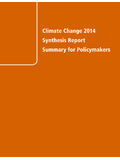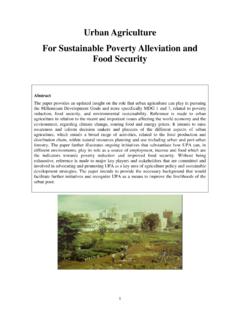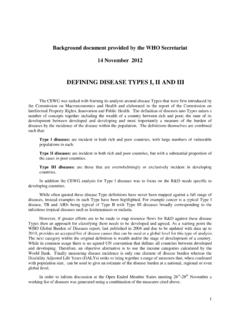Transcription of Final report for - Element Energy
1 Project Name Document Name 1 Demand side response in the non-domestic sector Final report for Ofgem July 2012 Element Energy Limited 20 Station Road Cambridge CB1 2JD Tel: 01223 852499 Demand side response in the non-domestic sector Final report Contents 1 Summary .. 1 Overview .. 1 Electricity demands in the non-domestic sector .. 2 DSR technical potential .. 4 Barriers and enablers .. 5 Conclusions .. 6 2 Introduction .. 8 Context .. 8 Aims and scope .. 9 Overview of demand side response .. 9 Methodology .. 14 3 Electricity use in non-domestic buildings .. 16 Characterising the non-domestic building 16 Annual electricity consumption in non-domestic buildings.
2 16 Sub-sector demand profiles .. 18 Aggregated demand profiles .. 26 4 Potential for demand side response in non-domestic buildings .. 29 Overview .. 29 Overall DSR potential .. 31 Demand side response measures .. 34 5 Barriers to uptake of demand side response 47 47 Barriers .. 49 Enabling mechanisms .. 53 6 Conclusions .. 56 7 Appendix .. 60 Detailed methodology: generating average demand profiles .. 60 Characterising the Other sub-load category .. 64 Demand side response enablers to access the technical potential .. 65 Demand side response in the non-domestic sector Final report Authors This report has been prepared by Element Energy in partnership with De Montfort University.
3 For comments or queries please contact: Michael Dolman 01223 852494 Ian Walker 0330 119 0981 Andrew Wright 0116 257 7960 Graeme Stuart 0116 255 1551 Acknowledgements The authors are grateful to all individuals and organisations that assisted with and provided input to this study. In particular, thanks are due to: British Council of Offices British Council of Shopping Centres British Institute of Facilities Management British Land British Property Federation Boots Chesterfield Borough Council Flexitricity GE Capital Hammerson Kiwi Power Leicester City Council M&C Energy Major Energy Users Council Marks and Spencer Power Efficiency Prupim RLtec Sainsbury s Scarborough and North East Yorkshire NHS Trust Tesco The Facilities Management Association UK Green Building Council Vinci Facilities Demand side response in the non-domestic sector Final report Glossary AC Air conditioning AHU Air handling unit BM Balancing mechanism CHP Combined
4 Heat and power CPP Critical peak pricing CRC Carbon reduction commitment CSR Corporate social responsibility DECC Department of Energy and Climate Change Defra Department for Environment, Food and Rural Affairs DNO Distribution network operator DSR Demand side response DUKES Digest of UK Energy Statistics DUoS Distribution use of system GHG Greenhouse gas GW Gigawatt (unit of power equal to 1,000MW) GWh Gigawatt hour (unit of Energy ) HHM Half-hourly metered HVAC Heating, ventilation and air conditioning1 IEA International Energy Agency LED Light emitting diode MW Megawatt (unit of power equal to 1,000kW) RTP Real-time pricing STOR Short term operating reserve T&D Transmission and distribution TOU Time of use TWh Terawatt hour (unit of Energy equal to 1,000 GWh) US United States of America 1 HVAC is used in this report to refer to the combined electricity demands of heating, ventilation and air conditioning.
5 Although a distinction is made between Heating and AC & ventilation ( see Figure 8 section ), the HVAC term is used to cover all of these sub-loads. Demand side response in the non-domestic sector Final report 1 1 Summary Overview Context Secure electricity supplies are largely taken for granted in the UK and are fundamental to our economy and society. The expected increase in electricity demands over the coming years2, combined with significant changes to the generation mix will result in challenges to maintaining secure, affordable supplies. The UK s electricity system is currently sized to meet peak demands (that only occur infrequently), which leads to generating plant and transmission and distribution networks being under-utilised for much of the time.
6 Various measures may be used to encourage consumers to reduce demands for electricity during peak periods, or to shift consumption to times of low demand. Economy 7 electricity tariffs are a familiar example in the UK, targeted at domestic consumers (particularly those that use electric heating), offering a lower electricity price overnight (when overall demands on the grid are lower). Demand side response (DSR) is a broad term that refers to a range of mechanisms designed to reduce peak demands on the electricity system, potentially delivering a number of benefits including reduced cost of electricity supply and improved efficiency of investment in transmission and distribution networks (see section ).
7 Although uptake in the UK has been low to date, DSR has been identified as one of the mechanisms that could contribute to future security of electricity The UK Energy regulator Ofgem requires an understanding of the potential impact of DSR and its role in managing future load growth on the electricity network. This study has been undertaken to explore the potential for DSR in the non-domestic sector. Aims, scope and methodology The principal aims of this research are to: Quantify the technical potential for demand side response in non-domestic buildings. Assess the barriers to further uptake of demand side response and identify enabling mechanisms required for the potential to be realised.
8 The study is limited to considering electricity demands in the non-domestic building sector, excluding Energy -intensive industrial processes. For the purposes of this study s analysis all non-domestic buildings are represented by ten sub-sectors (see section ). In terms of geographical coverage, the focus of the modelling work is Great Britain only. Two main tasks were undertaken to achieve these objectives: 2 Demand increases are expected due to population growth and increased electrification of sectors such as heat and transport. A shift from fossil fuels to electricity, combined with greater uptake of renewables, has been identified as a means of improving diversity of Energy supply and meeting GHG emission reduction targets.
9 3 For example, see the UK Government s technical update to the White Paper on Electricity Market Reform. Demand side response in the non-domestic sector Final report 2 A consultation with Energy consumers and other stakeholders in the relevant sub-sectors to gather information on electricity demands and the current levels of engagement with and barriers to DSR. A data modelling exercise in which demand profiles for a selection of building types were analysed (based on half-hourly metered electricity consumption data), and overall demands from non-domestic buildings on the national grid were estimated.
10 Further details of the methodology are provided in sections and Electricity demands in the non-domestic sector From an understanding of annual electricity consumption by sub-sector and typical demand profiles of premises within each sub-sector we estimate the contribution of non-domestic buildings to peak electricity demands. Figure 1: Demand on British national grid for a week day in winter4 This graph shows the demand profile for non-domestic buildings (excluding industry), compared to total demands on the grid from all sectors. We see from the above that peak demands due to non-domestic buildings occur at around 11am, and that this sector contributes around 15GW (30%) to the evening peak on a typical winter week day.







